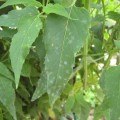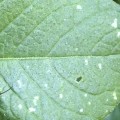Quick Intro
Physical Description
Species & Taxonomy
- Kingdom:
- Phylum:
- Class:
- Order:
- Family:
- Genus Species: Fusarium oxysporum f. sp. callistephi
Plants Affected
Aster family plants:
- aster
- daisy
- sunflower
- lettuce
- artichokes
- marigold
- chrysanthemums
- dahlias
- zinnias
- echinacea
- yarrow
Plants Unaffected
Geographical Range
Signs & Symptoms
Whole Plant
- rapid wilting of the plant, often followed by death
- stem base blackens and shrinks inward
- faint, furry, pale pink or white fungal growth may develop
Leaves
Flowers
Fruit
Roots/Tubers
How to Positively Identify
Treatment
- promptly remove and dispose of infected plants and the soil in the vicinity of the roots
- Fusarium can be killed with high heat, but most techniques of heating the soil don’t go deep enough into the soil
- try soil solarization
Prevention & Control
Treatment is very difficult, so controlling the spread of the fungus is important:
- promptly remove and dispose of infected plants and the soil in the vicinity of the roots
- Use a fresh site for future plantings of asters and plant only healthy-looking stock
- discard any with dead roots or damaged stem bases
- avoid planting asters on heavy soils, or improve soil texture before planting
- grow resistant cultivars



